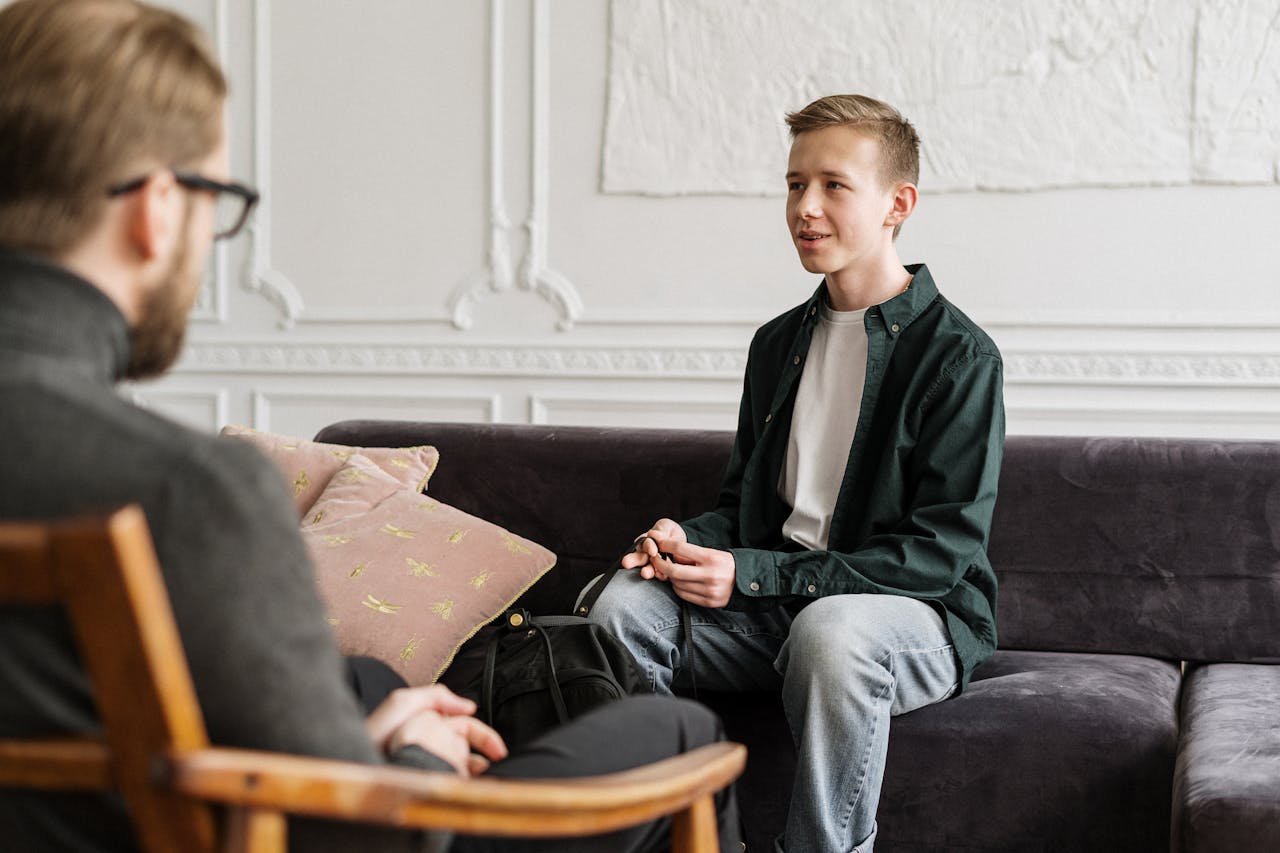Post-traumatic stress disorder, or PTSD, affects people after a traumatic event. It impacts their mental health and well-being. The journey to recovery is unique for each person. But, with the right approach, support, and treatment, it’s possible to manage PTSD and regain control of life.
It’s important to understand that PTSD is not a sign of weakness. It’s a legitimate response to a traumatic experience. By acknowledging the effects of trauma and seeking help, individuals can start healing and managing their PTSD.
The path to recovery from PTSD and trauma requires patience and self-care. It involves understanding the condition, recognizing its signs and symptoms, and finding the right treatment. With the right mindset and support, individuals can navigate the challenges of PTSD and work towards a fulfilling life.
Key Takeaways
- PTSD, or post-traumatic stress disorder, is a condition that affects individuals after a traumatic event.
- Trauma can have a significant impact on a person’s mental health and well-being.
- Recovery from PTSD is unique for each individual and requires a comprehensive approach.
- Seeking help and support is crucial for managing PTSD and trauma.
- With the right treatment and mindset, individuals can regain control of their lives and work towards a fulfilling future.
- Understanding and acknowledging the effects of trauma is essential for recovery from PTSD.
Understanding PTSD: More Than Just Stress
Post-traumatic stress disorder (PTSD) is a complex condition that deeply affects mental health. It’s not just stress or anxiety. PTSD is a serious condition that needs professional help and care. It can happen to anyone, from combat and abuse to natural disasters and accidents.
When someone goes through trauma, their body’s fight-or-flight response kicks in. This changes brain chemistry, affecting mood, sleep, and thinking. This response is natural, but in PTSD, it gets stuck, causing ongoing anxiety and distress.
Many people think PTSD only affects veterans or that it’s easy to “get over.” But PTSD is a serious condition that needs treatment and support. By understanding PTSD, we can reduce stigma and help improve mental health for those affected.
What Causes PTSD?
- Combat and physical abuse
- Natural disasters and accidents
- Emotional trauma and neglect
The Science Behind Trauma Response
The body’s reaction to trauma is complex, involving the nervous system and brain chemistry. Understanding this helps us see why PTSD needs comprehensive treatment and support.
Recognizing the Signs and Symptoms of PTSD
It’s key to know the signs and symptoms of PTSD to get help and start healing. Common ptsd symptoms can differ from person to person. They might include flashbacks, severe anxiety, and thoughts that won’t stop. Physical signs like headaches and trouble sleeping can also happen.
Some common signs of PTSD include:
- Flashbacks or nightmares related to the traumatic event
- Severe anxiety or fear
- Uncontrollable thoughts about the trauma
- Physical symptoms like headaches or sleep problems
Understanding coping strategies is crucial for managing PTSD symptoms. Techniques like grounding, stress management, and adjusting daily routines can help. Recognizing PTSD signs and getting help is the first step towards recovery.
Early action is vital for effective treatment and recovery. Knowing the common signs and symptoms of PTSD helps individuals seek help. This is the first step towards healing and recovery.
The Impact of PTSD on Daily Life
Living with PTSD can deeply affect daily life, impacting not just the person but also their loved ones. It can cause physical health issues, emotional struggles, and social problems. Anxiety is a common symptom that can be very hard to handle if not treated.
Through therapy and counseling, people with PTSD can learn to manage their symptoms. They can improve their life quality. This might include learning stress management and grounding exercises to handle anxiety and other emotional challenges.
PTSD can impact daily life in many ways, including:
- Physical health problems, such as chronic pain and sleep disturbances
- Emotional struggles, including anxiety and depression
- Social difficulties, such as isolation and strained relationships
Seeking professional help, like counseling or therapy, is a first step towards recovery. With the right support and treatment, managing PTSD symptoms and improving daily life is possible.
Remember, PTSD is treatable, and recovery is possible. Acknowledging PTSD’s impact and seeking help are the first steps towards healing and rebuilding one’s life.
| PTSD Symptom | Effect on Daily Life |
|---|---|
| Anxiety | Difficulty sleeping, irritability, and mood swings |
| Depression | Loss of interest in activities, changes in appetite, and fatigue |
| Social isolation | Strained relationships, difficulty forming new connections, and feelings of loneliness |
When to Seek Professional Help
Knowing when to get help for PTSD is key. If symptoms make daily life hard, or if self-help doesn’t work, it’s time to see a mental health expert. Treatment options are out there to help manage PTSD, and getting help is a big step towards getting better.
Signs you might need professional help include feeling hopeless, having suicidal thoughts, or struggling with everyday tasks. A mental health professional can offer support and help create a treatment plan just for you.
When looking for help, find a therapist or psychologist who knows about PTSD. They can teach you coping skills and offer different treatment options, like therapy and medicine. Taking this step can start you on the path to healing and better mental health.
- Recognize the signs and symptoms of PTSD
- Seek help from a mental health professional
- Develop a personalized treatment plan
Seeking professional help is a sign of strength, not weakness. It’s the first step towards healing and recovery from PTSD.
Different Types of PTSD Treatment Options
There are many ways to manage PTSD. Each person can find a treatment that fits their needs. This makes therapy and counseling more personal. The main types of treatment are psychotherapy, medication, and alternative therapies.
People can try different therapies like cognitive-behavioral therapy (CBT) and eye movement desensitization and reprocessing (EMDR). These help people deal with their trauma and learn how to cope.
Psychotherapy Approaches
- Cognitive-behavioral therapy (CBT)
- Eye movement desensitization and reprocessing (EMDR)
- Psychodynamic therapy
Medication Options
Medicine might be part of a treatment plan for some. Antidepressants and anti-anxiety drugs are often used. But, it’s best to use them with therapy and counseling for the best results.
Alternative Therapies
Therapies like mindfulness and yoga can also help with PTSD. They help people relax and reduce stress. By trying different treatments and working with a mental health expert, people can find what works best for them.
| Treatment Option | Description |
|---|---|
| Psychotherapy | Helps individuals process traumatic experiences and develop coping strategies |
| Medication | Manages symptoms of PTSD, such as depression and anxiety |
| Alternative Therapies | Promotes relaxation and reduces stress |
Building Your Support Network
Having a strong support network is key for PTSD recovery. It makes you feel part of a community and less alone. Your network can be family, friends, or support groups.
Talking to loved ones and joining groups can connect you with others who’ve gone through similar things. This connection helps with coping strategies and recovery. Here are ways to grow your support network:
- Reach out to family and friends to share feelings and experiences.
- Join support groups, online or in-person, to meet others who’ve faced similar challenges.
- Connect with others through social media or online forums who have gone through similar things.
A strong support network helps you find better coping strategies and improves your well-being. It makes you feel less alone and more supported on your recovery path.
Building a support network takes time and work, but it’s a vital step in recovery. With a strong network and good coping strategies, you can heal and move forward from PTSD.
Practical Coping Strategies for PTSD Management
Managing PTSD symptoms needs a mix of coping strategies. These include ways to lessen dissociation and anxiety. Learning grounding techniques, like deep breathing and physical activity, can help. These methods can be added to daily life to manage anxiety and boost well-being.
Some effective coping strategies for PTSD management include:
- Grounding techniques: focusing on the present moment to reduce dissociation
- Stress management tools: utilizing exercise, meditation, or yoga to reduce anxiety
- Daily routine adjustments: establishing a consistent sleep schedule and healthy habits to improve overall well-being
By using these strategies, people can manage their PTSD symptoms and lower anxiety. Remember, everyone’s PTSD experience is different. What works for one might not work for another. So, it’s key to work with a mental health professional to create a plan that fits your needs.
The Role of Self-Care in Recovery
Self-care is key in recovering from PTSD. It helps people feel better about themselves, lowers stress, and boosts mental health. Activities like meditation, nature walks, and hobbies help a lot. They make recovery easier.
By focusing on self-care, people can handle their symptoms better. This improves their overall health and well-being.
Some great self-care ideas for recovery include:
- Practicing mindfulness and meditation to reduce stress and anxiety
- Engaging in physical activity, such as walking or yoga, to improve mood and reduce symptoms
- Pursuing creative hobbies, such as painting or writing, to express emotions and promote healing
Adding these self-care activities to daily life helps manage mental health better. It’s important to remember that self-care is personal. What works for one might not work for another. So, it’s good to try different things to find what works best.
Putting self-care at the center of recovery plans can greatly improve mental health. It’s not just nice to have; it’s necessary for good mental health and overall well-being.
Supporting a Loved One with PTSD
Supporting someone with PTSD needs empathy and understanding. A strong support network is key for recovery. It gives a sense of safety and comfort. Being part of this network helps your loved one find ways to cope with PTSD.
Don’t forget to take care of your own mental health. Setting boundaries and seeking help is important. Here are some ways to support your loved one:
- Encouraging them to seek professional help
- Helping them develop a daily routine
- Creating a safe and comfortable environment
Being supportive and understanding is crucial. Remember to take care of your own mental health too. With the right support network and coping strategies, your loved one can manage their PTSD better.
Professional Resources and Support Groups
Recovering from PTSD needs a full approach. This includes professional help and support groups. These places offer a safe space to share, get advice, and learn how to cope. Therapy and counseling are key, helping people deal with their feelings and tough experiences.
Some important resources are:
- Therapy sessions with a licensed therapist
- Counseling services for individuals and groups
- Support groups for individuals with PTSD and their loved ones
Finding the Right Therapist
Finding the right therapist is very important. You should look for someone who knows a lot about PTSD and has worked with others like you.
Online Support Communities
Online support groups are a great way to connect with others. They offer a sense of belonging and support, which is vital for healing from PTSD.
| Resource | Description |
|---|---|
| Online support groups | Virtual groups that connect individuals with PTSD and their loved ones |
| Crisis intervention services | Emergency services that provide immediate support and guidance |
Long-Term Recovery and Growth
Recovery from PTSD is a journey of growth and healing. It’s not just about managing symptoms. It’s about achieving personal growth and healing. As people get better, they see big improvements in their mental health.
Key parts of long-term recovery include rebuilding your life and setting goals. Finding meaning and purpose is also important. Therapy, self-care, and support networks help a lot. They help you live a fulfilling life without PTSD’s hold.
Some ways to promote long-term recovery and growth are:
- Setting realistic goals and working towards them
- Practicing self-care and stress management techniques
- Building and maintaining a strong support network
- Engaging in activities that promote mental and emotional well-being
By using these strategies and focusing on mental health, you can achieve lasting recovery and growth. With the right support and mindset, you can beat PTSD and live a fulfilling life.
Conclusion
The journey to beat PTSD is not straightforward. It’s a path with ups and downs. But, with the right help, strategies, and focus on mental health, people can take back their lives. They can find a strength they never knew they had.
This article has given a detailed guide on PTSD. It covers how to spot the signs and find effective treatments. Building a support network, taking care of oneself, and getting professional help are key. These steps help those affected by trauma face their challenges and find growth.
The road ahead is tough, but it’s also full of hope. As people keep moving forward, they find the courage to face obstacles. They learn to appreciate life’s beauty and its fragility. With each success, the way to healing becomes clearer. A fulfilling, trauma-informed life becomes a real possibility.


